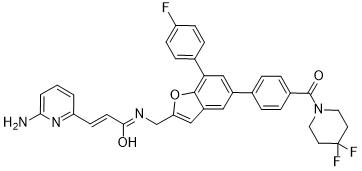All AbMole products are for research use only, cannot be used for human consumption.

KPT-9274, also known as PAK4-IN-1, is a potent, selective and dual PAK4/NAMPT inhibitor with IC50s less than 100 and 120 nM, respectively. KPT-9274 interferences with PAK4/NAMPT signaling pathways, which results in reduction of G2-M transit as well as induction of apoptosis and decrease in cell invasion and migration in several human RCC cell lines. KPT-9274 demonstrated the expected on-target effects in this mouse model. KPT-9274 (oral administation; 100mg/kg or 200 mg/kg; twice a day; 14 days) demonstrates a decrement of xenograft growth and exists no significant weight loss in animals receiving KPT-9274. 8 hours after, KPT-9274 are measured at the end of the experiment in mouse plasma and tumors with 10757 ng/ml and 10647 ng/ml, respectively.
| Molecular Weight | 610.63 |
| Formula | C35H29F3N4O3 |
| CAS Number | 1643913-93-2 |
| Solubility (25°C) | DMSO ≥ 62 mg/mL |
| Storage |
Powder -20°C 3 years ; 4°C 2 years In solvent -80°C 6 months ; -20°C 1 month |
| Related PAK Products |
|---|
| st-Ht31
st-Ht31 is a membrane-permeable peptide inhibitor of protein kinase A (PKA) anchoring. |
| AZA197
AZA197 is a selective small molecule inhibitor of Cdc42.AZA197 suppresses colon cancer cell proliferation, cell migration, invasion and increases apoptosis by down-regulating the PAK1 and ERK signaling pathways in vitro. |
| ZMF-23
ZMF-23 is a PAK1/HDAC6 dual inhibitor. |
| PF-3758309 dihydrochloride
PF-3758309 (PF-03758309) dihydrochloride is a potent, orally available, and reversible ATP-competitive inhibitor of PAK4 (Kd= 2.7 nM; Ki=18.7 nM). PF-3758309 dihydrochloride has the expected cellular functions of a PAK4 inhibitor: inhibition of anchorage-independent growth, induction of apoptosis, cytoskeletal remodeling, and inhibition of proliferation. |
| AZ13705339 hemihydrate
AZ13705339 hemihydrate is a highly potent and selective PAK1 inhibitor with IC50s of 0.33 nM and 59 nM for PAK1 and pPAK1, respectively. AZ13705339 hemihydrate has binding affinities to PAK1 and PAK2, with Kds of 0.28 nM and 0.32 nM, respectively. AZ13705339 hemihydrate can be used in the research of cancers. |
All AbMole products are for research use only, cannot be used for human consumption or veterinary use. We do not provide products or services to individuals. Please comply with the intended use and do not use AbMole products for any other purpose.


Products are for research use only. Not for human use. We do not sell to patients.
© Copyright 2010-2024 AbMole BioScience. All Rights Reserved.
